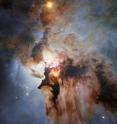Stormy seas in Sagittarius
Some of the most breathtaking views in the Universe are created by nebulae - hot, glowing clouds of gas. This new NASA/ESA Hubble Space Telescope image shows the centre of the Lagoon Nebula, an object with a deceptively tranquil name. The region is filled with intense winds from hot stars, churning funnels of gas, and energetic star formation, all embedded within an intricate haze of gas and pitch-dark dust. Nebulae are often named based on their key characteristics - particularly beautiful examples include the Ring Nebula (heic1310), the Horsehead Nebula (heic1307) and the Butterfly Nebula (heic0910). This new NASA/ESA Hubble Space Telescope image shows the centre of the Lagoon Nebula, otherwise known as Messier 8, in the constellation of Sagittarius (The Archer).
The inspiration for this nebula's name may not be immediately obvious - this is because the image captures only the very heart of the nebula. The Lagoon Nebula's name becomes much clearer in a wider field view (opo0417i) when the broad, lagoon-shaped dust lane that crosses the glowing gas of the nebula can be made out.
Another clear difference between this new image and others is that this image combines both infrared and optical light rather than being purely optical(heic1015). Infrared light cuts through thick, obscuring patches of dust and gas, revealing the more intricate structures underneath and producing a completely different landscape [1].
However, even in visible light, the tranquil name remains misleading as the region is packed full of violent phenomena.
The bright star embedded in dark clouds at the centre of this image is known as Herschel 36. This star is responsible for sculpting the surrounding cloud, stripping away material and influencing its shape. Herschel 36 is the main source of ionising radiation [2] for this part of the Lagoon Nebula.
This central part of the Lagoon Nebula contains two main structures of gas and dust connected by wispy twisters, visible in the middle third of this image (opo9638). These features are quite similar to their namesakes on Earth - they are thought to be wrapped up into their funnel-like shapes by temperature differences between the hot surface and cold interior of the clouds. The nebula is also actively forming new stars, and energetic winds from these newborns may contribute to creating the twisters.
This image combines images taken using optical and infrared light gathered by Hubble's Wide Field Planetary Camera 2.
Source: ESA/Hubble Information Centre
Other sources
- Dramatic Hubble pic reveals an interstellar "lagoon"from CBSNews - ScienceFri, 31 Jul 2015, 17:20:19 UTC
- Stormy seas in Sagittariusfrom Science DailyThu, 30 Jul 2015, 23:30:18 UTC
- Lagoon Nebula Seething With 'Violent Phenomena' | Videofrom Space.comThu, 30 Jul 2015, 20:30:23 UTC
- Hubble image: Stormy seas in Sagittariusfrom PhysorgThu, 30 Jul 2015, 14:30:28 UTC
